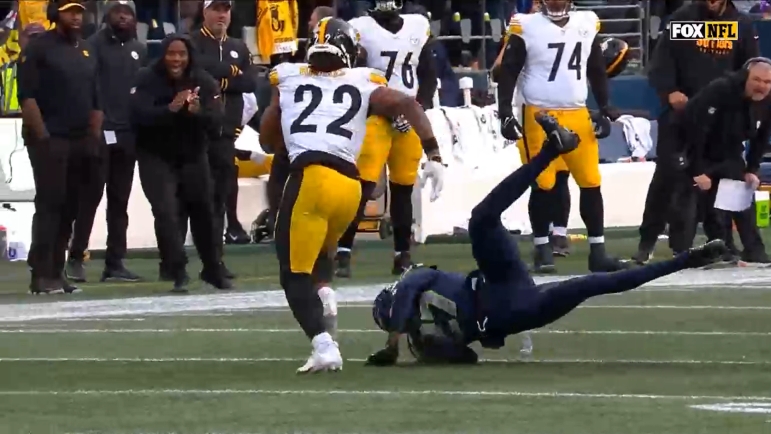estimating the market value of Steelers running back Najee Harris using the 2024 free agent class
Is there a chance Harris could remain in Pittsburgh long-term?
One of the biggest questions entering the 2024 offseason for the Pittsburgh Steelers front office is whether they would pick up RB Najee Harris’ fifth-year option.
That was answered on May 2nd, when in a bit of a surprise, the team declined to pick it up. If the option had been exercised, the black and gold would have owed Harris just 6.79 million in 2025 – a number that certainly wouldn’t have broken the bank.
Harris rushed for over 1,000 yards in his first three seasons and has been incredibly reliable – suiting up in 17 games in each of those campaigns. Was that not enough for the Steelers to have faith in him long-term? Potentially.
One thing is for certain – it’s a tough time to play running back in the NFL. We are seeing more backs struggle to work out a second contract with the team they started with than ever before.
It’s also much easier for the Steelers to possibly part ways because they have a backup like RB Jaylen Warren, who averaged 5.3 yards per carry last season and was one of the most explosive ball carriers in the league.

Given those factors, it’s fair to question whether this will be Harris’ last year with the black and gold. We could potentially help answer that question by gauging this past summer’s group of free-agent running backs and looking at how Harris stacks up.
Former Las Vegas Raiders RB (and another former Alabama back) Josh Jacobs signed a 4-year, $48 million contract with the Green Bay Packers, with an average annual value (AAV) of $12 million. That was the largest contract for any free-agent running back.
Yeah, those kinds of figures are not happening for Harris in Pittsburgh. Jacobs is closing in on 27 years old and is coming off a year in which he averaged just 3.5 yards per carry on 233 attempts. It’s important to add some context; he was on a disaster of a Raiders team and a late arrival to camp after a contract holdout. Still, in my opinion, that’s a big overpay.
The next biggest contract was handed out to Saquon Barkley by the Philadelphia Eagles, cashing in on a 3-year, $37.5 million contract with an AAV of $12.583 million. This makes more sense, given Barkley’s productive history and it appears he has some juice left in the tank. But the Steelers weren’t willing to give Harris half of that in 2025, I’d be shocked to see them double it in the 2025 offseason.
The next back on this list starts to get us a bit closer to Harris’ projected value. Former Eagles ball-carrier D’Andre Swift signed a 3-year, $24 million deal with the Chicago Bears, with an annual AAV of $8 million. It feels like Swift has been in the league forever, but he’s just 25 years old, which is younger than Harris. Swift also has much less tread on the tires, handling 593 carries in four years, compared to 834 for Harris in three seasons.
If I were an NFL GM and Harris were a free agent in 2024, I’d probably have slightly favored Swift.
But I think Harris will fall right under that number next season. The next highest-paid player on the list was former Dallas Cowboys RB Tony Pollard, who signed a 3-year deal worth $21.5 million with the Tennessee Titans.
If Harris does sign a three-year deal — which I fully anticipate — based on these figures I’d expect it to be around $22 million with an AAV around the $7.5 million mark.
It’s important to mention that this is all very fluid, and the upcoming season will determine if these numbers fluctuate. Of course, if Harris produces top-five numbers in the league – he will price himself out of the Steelers’ range. On the other hand, if he struggles or gets hurt, the contract situation will turn on its head. My guess is that his production resembles what we’ve seen in years past given the likely time-share with Warren.
I wouldn’t be completely shocked if the Steelers ventured into that $7 million range but given that they weren’t ready to pay him under his perceived market value this upcoming season, I can’t see them doing that long-term.











